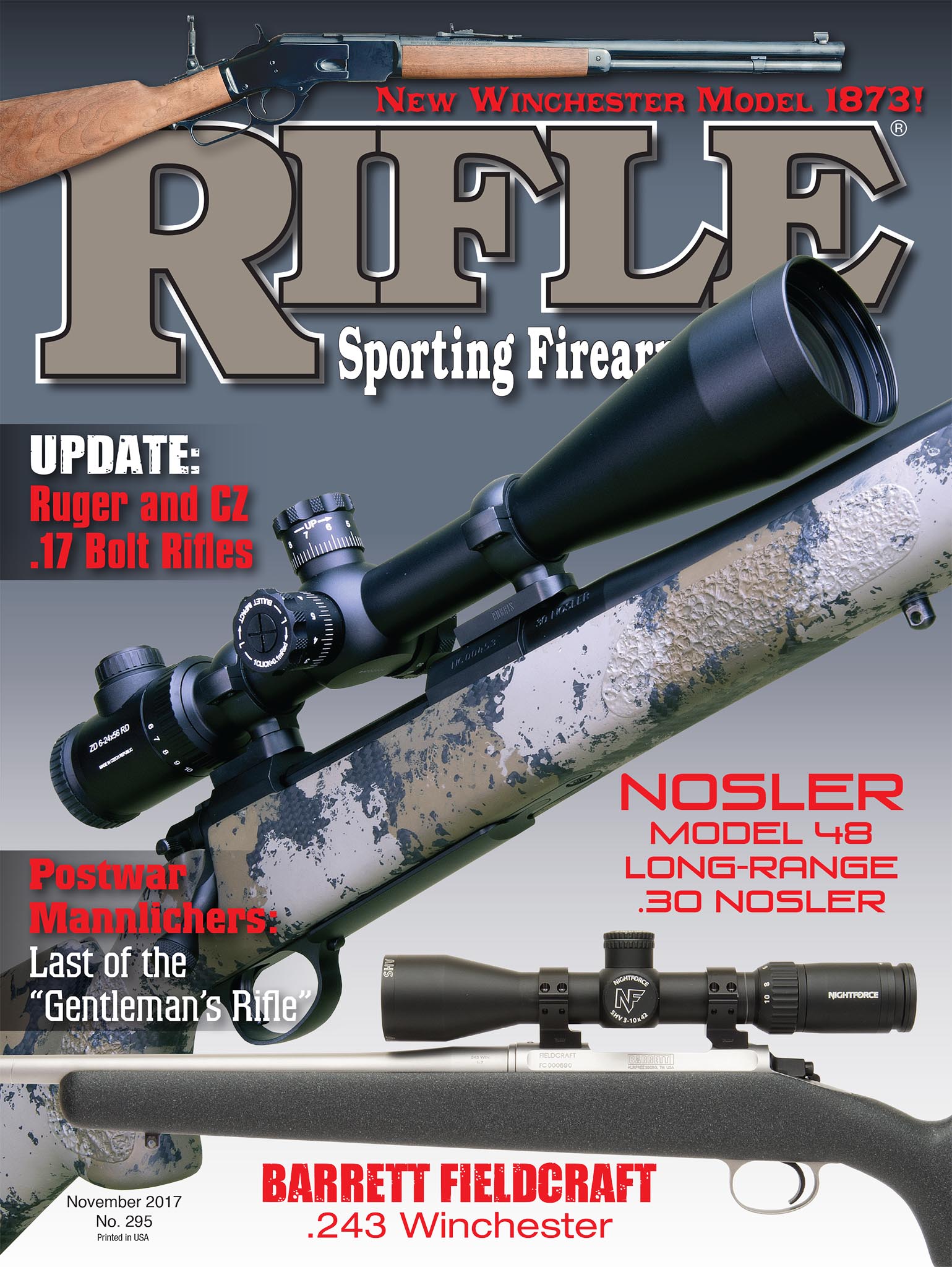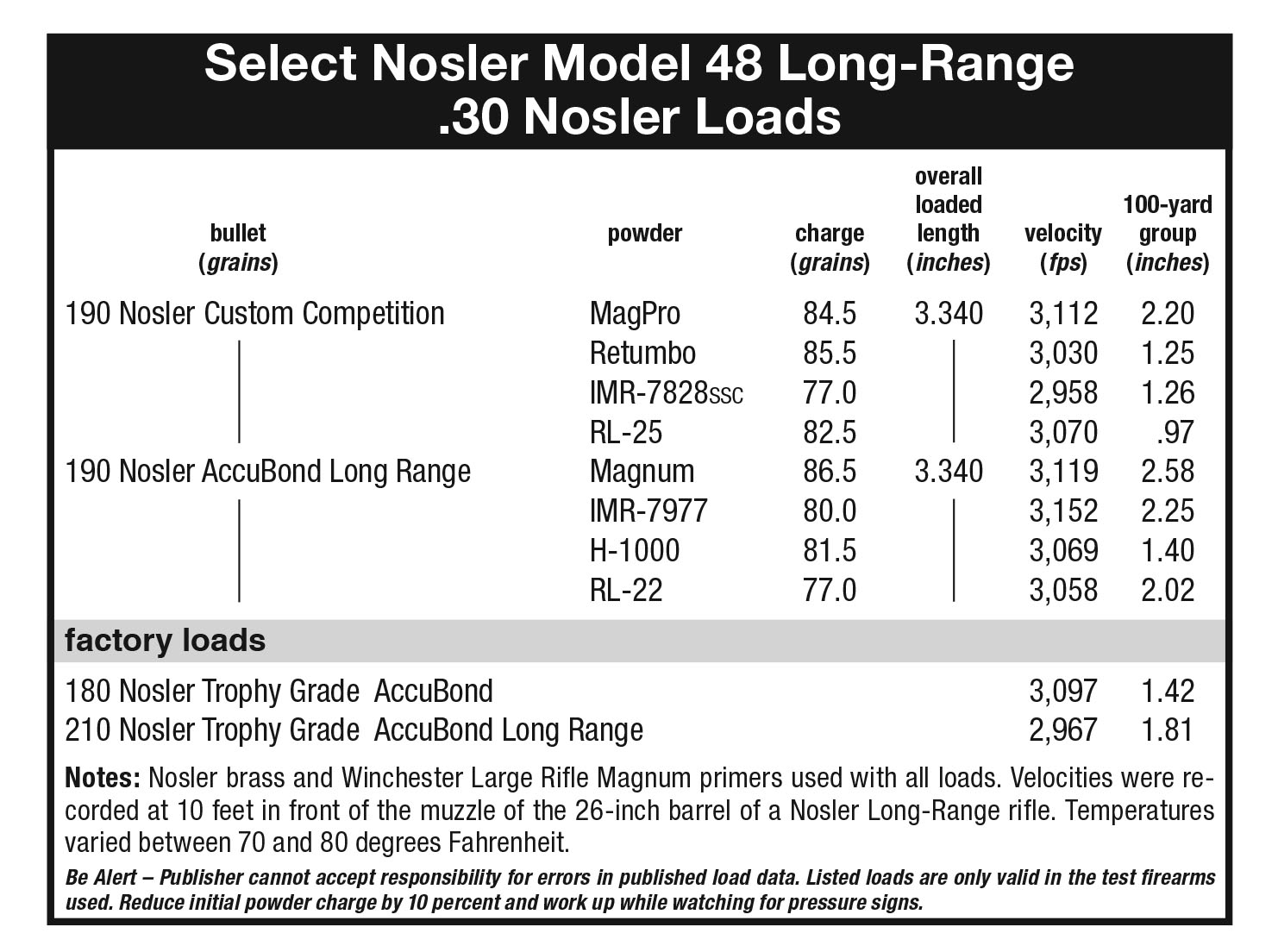Nosler Model 48 Long-Range
Testing a New .30 Nosler's MOA Accuracy Guarantee
feature By: John Haviland | November, 17
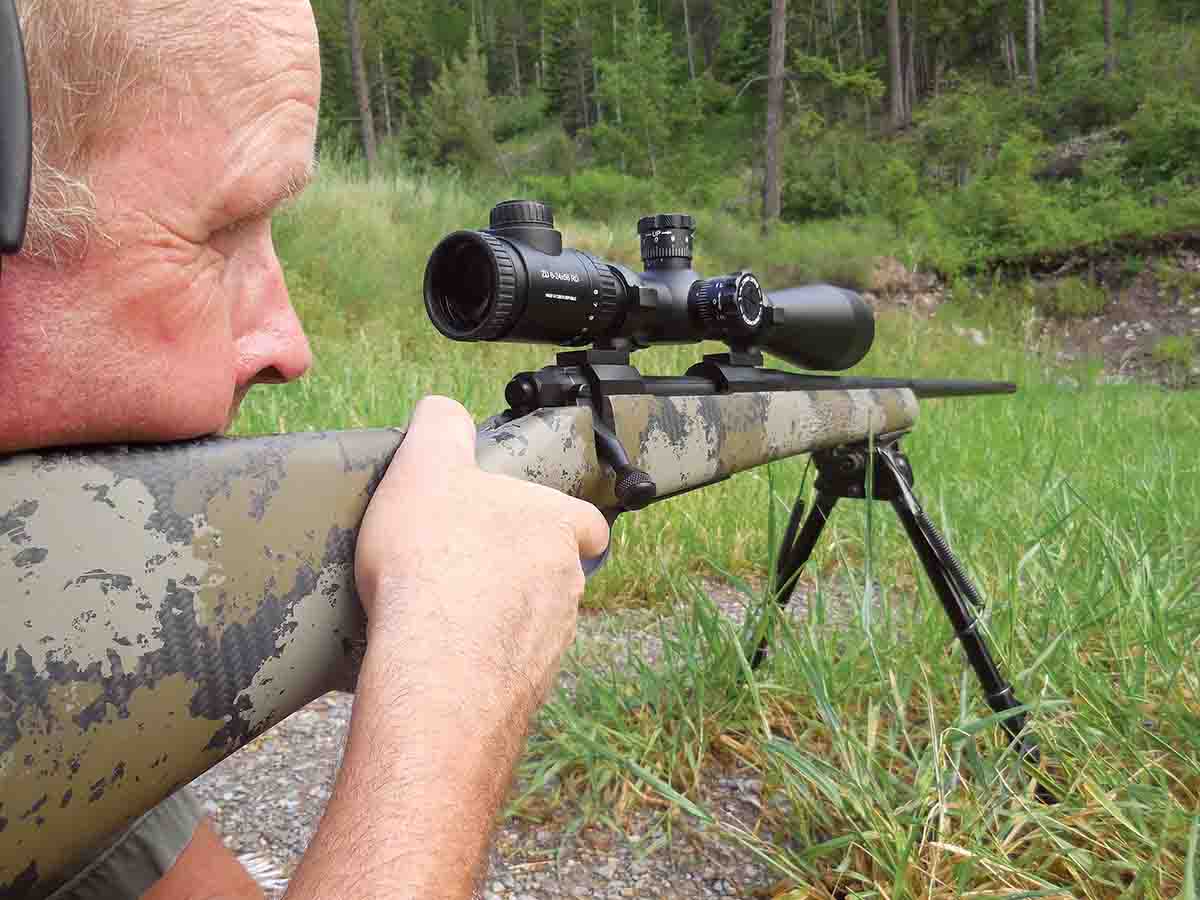
The Long-Range rifle is based on a long-action version of the Model 48. The action certainly reflects influences of the Remington 700 with a push-feed bolt, a plunger ejector on the recessed bolt face and large ejection port. A two-position safety does not lock the bolt closed in the engaged position, and a slot in the right bolt lug rides on a rail in the action. An aluminum trigger guard and floorplate are standard.
The Model 48 does have many distinctive features. The receiver has a flat bottom with an integral recoil lug threaded on the bottom to accept the front action screw. The “M16” style extractor is a spring-loaded leaf located on the left side of the right locking lug and hooks over a cartridge rim. The plunger on the bolt face throws cartridges and fired cases from the receiver when they clear the ejection port. A trim bolt release is located at the left of the rear bridge. The Timney trigger is set at a perfect 3 pounds.
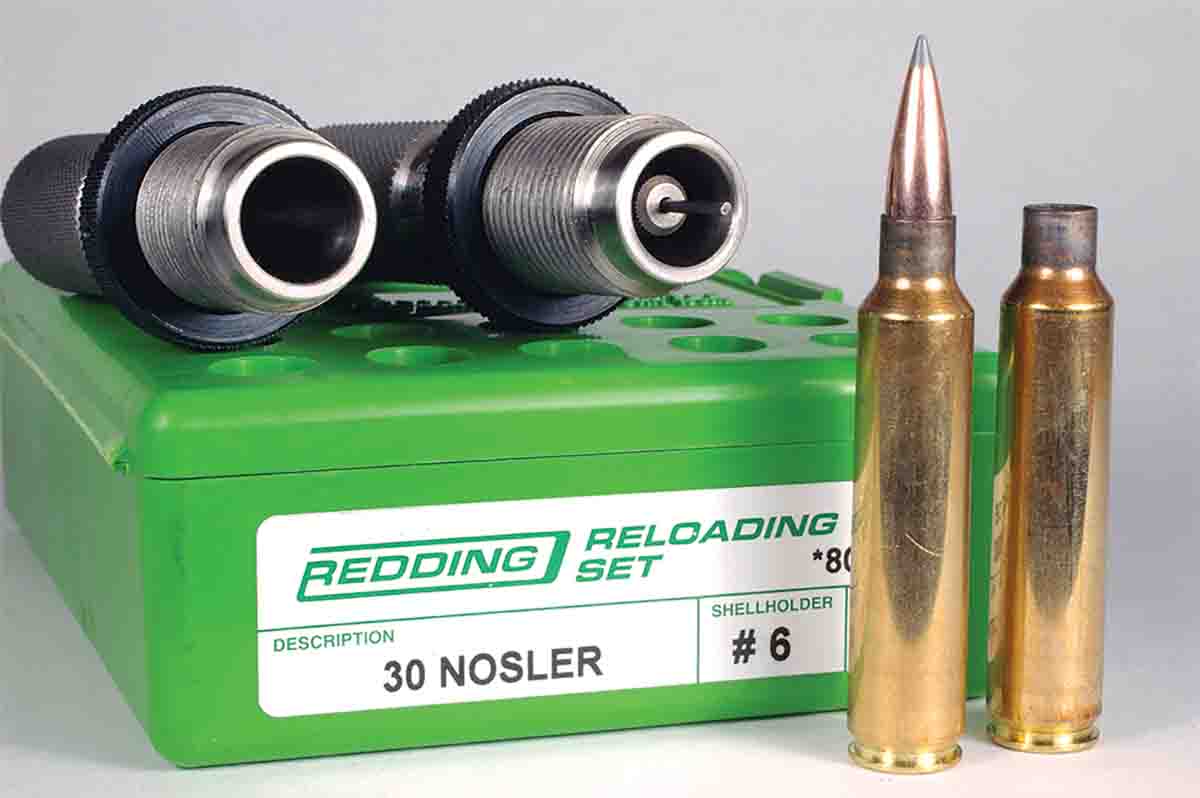
The Long-Range is chambered in 6.5 Creedmoor, .300 Winchester Magnum and the .26, .28, .30 and .33 Noslers. Rifles for all cartridges feature a 26-inch barrel Nosler states is “heavy.” The Shilen stainless steel barrel looks more like a “medium” contour with a diameter of 1.15 inches in front of the receiver that tapers to .65 inch at the muzzle. A removable muzzle brake threads onto the muzzle; rifle length is a long 48.5 inches with the brake installed. Removing the brake shortens that length by 2 inches. A cap screws flush onto the muzzle to protect the threads and gives the muzzle a finished look. All the metal is coated with CERAKOTE.
The barreled action is attached to a Manners Composite Stocks MCS-T Elite Tactical synthetic stock with the rear and front action screws passing through aluminum pillars cemented into the stock. Bedding material, on the inletting for the rear tang, around the recoil lug recess and on the flat behind the recoil lug, completes the bedding. The barrel is free floated. Bedding is tight, and a lot of back-and-forth rocking of the barreled action is required to separate it from the stock.
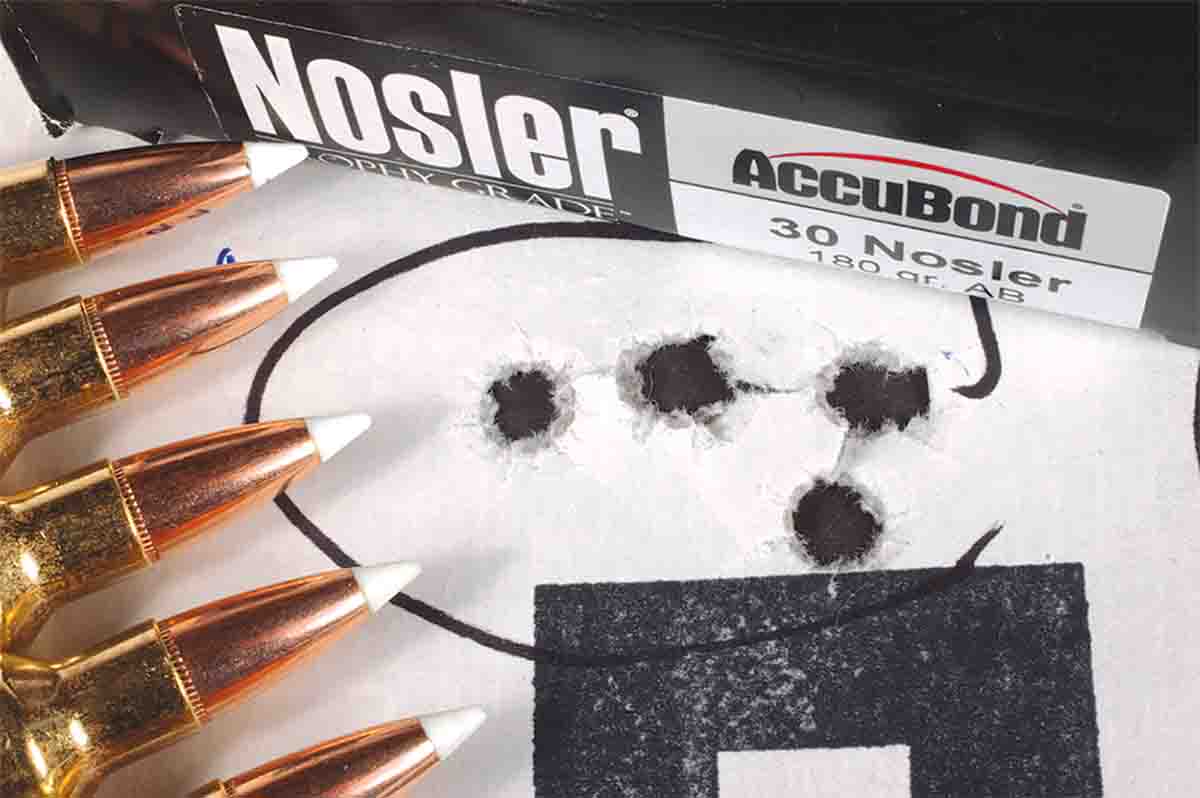
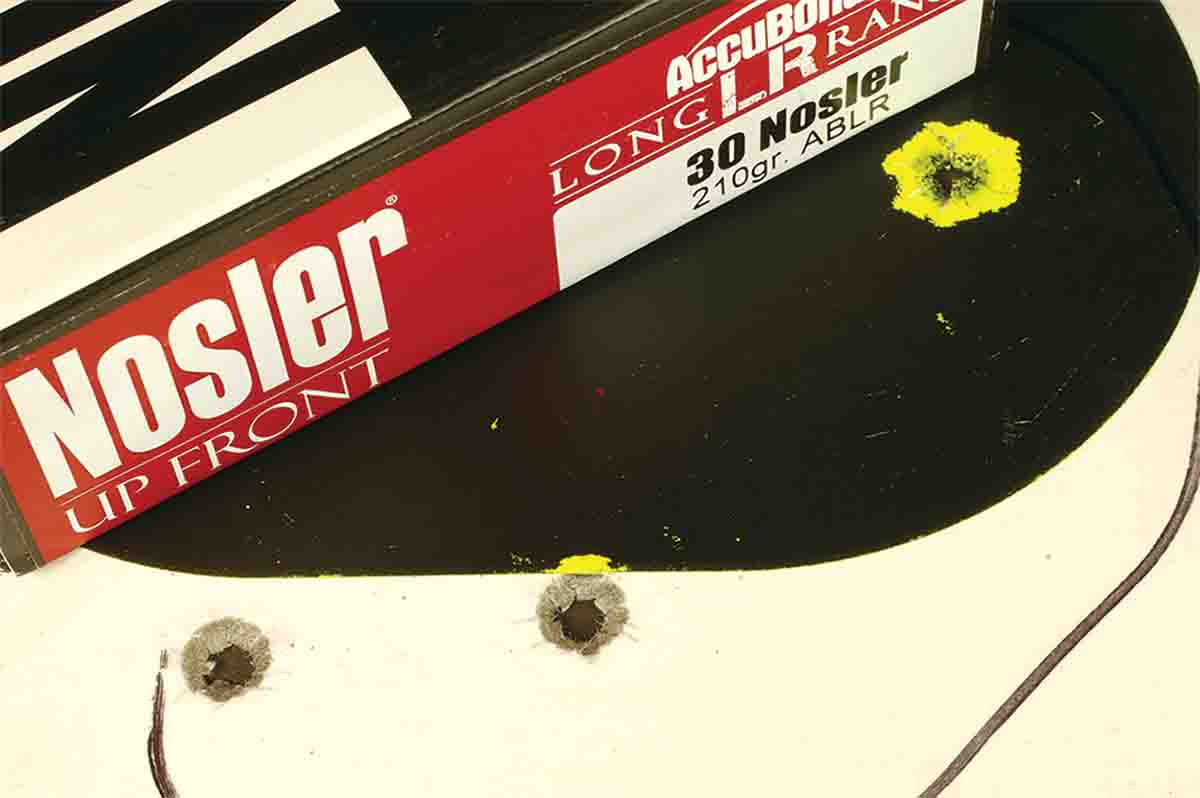
The stock has a high comb that drops only .38 inch from the bore’s centerline. A slot in the nose of the comb provides clearance for the retracted bolt. A slight forward slant to the comb pulls it away from the face during recoil. In the tactical style, the grip is nearly vertical with a palm swell on the right side. The grip is so large my hand would not fit around it. Rough panels on both sides of the forearm and grip provide a good grasp on the stock. The stock is available in five camouflage patterns.
A rifle called the Long-Range will be mostly shot from the prone position in the field. Usually, a stock dedicated to prone shooting has a slightly longer length of pull than a stock used while standing or sitting. The test rifle’s stock, however, has a 13.5-inch length of pull, which is about standard for a general stock.
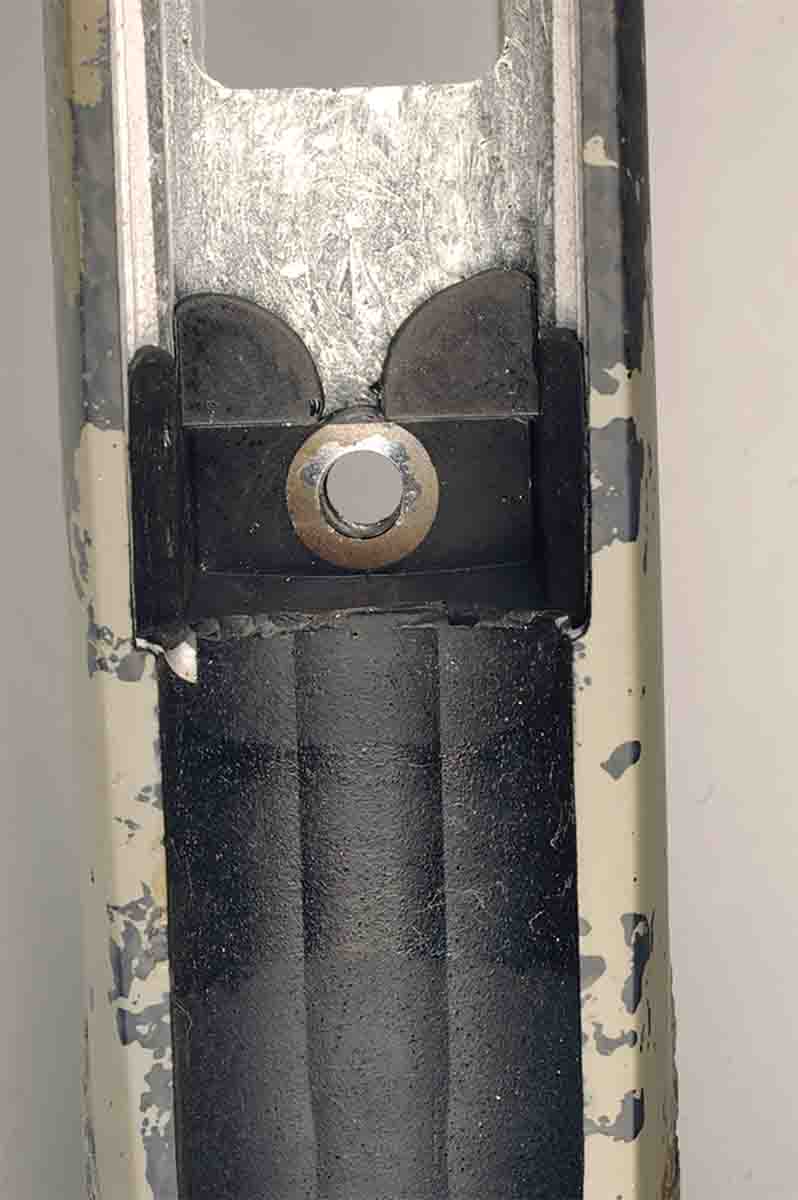
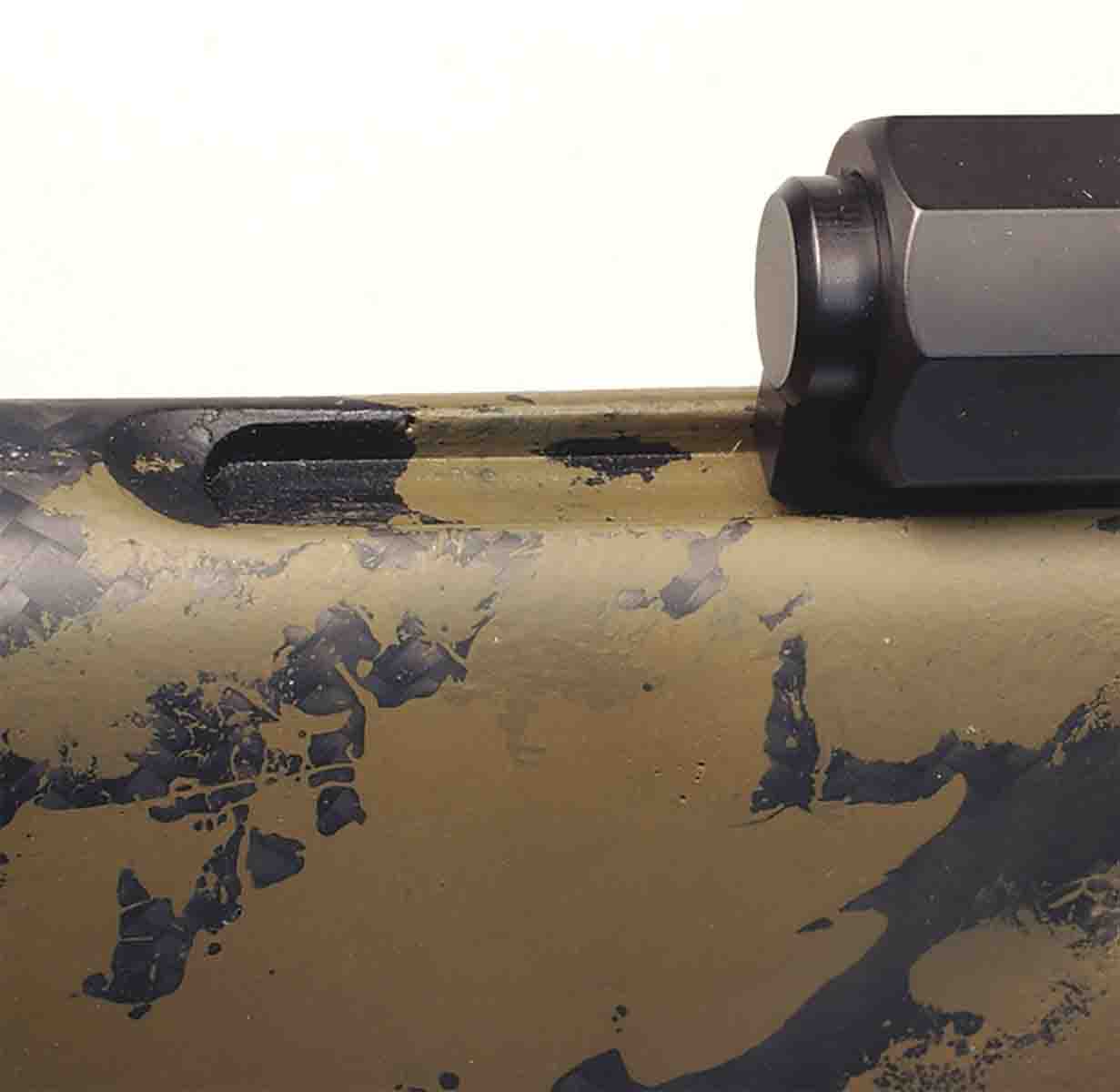
Nosler recommends breaking in the new barrel on its rifles. “When new barrels are made, steel is unevenly stressed and microscopic burs and rough-spots are created,” Nosler’s website states. That does not give credit to Shilen’s ability to make a finished barrel. A look with a Lyman borescope into the Shilen stainless steel barrel on the test rifle showed the lands and grooves were fairly smooth from breech to muzzle, with the metal’s grain running with the bore. Very few places in the bore had slight crosswise tool marks in the grooves.
To relieve metal stress and put a final polish on a bore, Nosler recommends cleaning the barrel after each shot for 10 rounds, then clean after every three shots for 15 rounds, then clean the barrel after five shots. The barrel must cool between each series of shots. All that counting makes my head hurt. Plus, watching clouds sail past becomes boring while waiting for a barrel to cool between shot strings.
I pampered the barrel by shooting a few shots and spending a minute between shots while adjusting the Meopta scope to dial it in at 25 yards, then went through the same process to sight in the scope at 100 yards. No more than five cartridges were fired in a row, because that many shots heated the barrel enough to cauterize a wound.
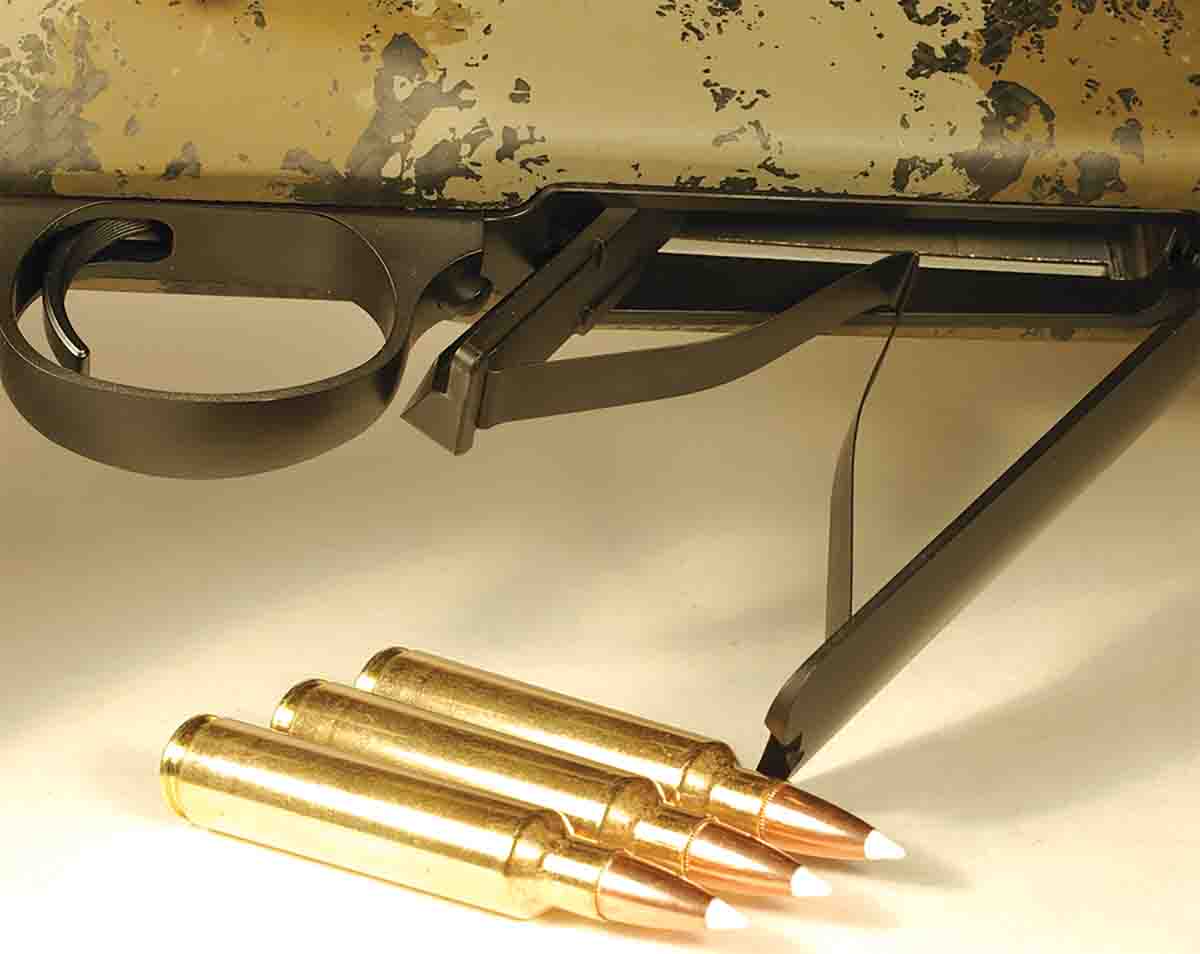
The Long-Range, weighing 7 pounds, 10 ounces, is rather light for a .30-caliber magnum. The weight, however, was increased to 9 pounds, 13 ounces with the addition of a Meopta ZD 6-24x 56mm RD scope in Burris Signature rings and two-piece bases. That’s a load.
The .30 Nosler joins a crowded field of .300 magnum cartridges. Nosler says its cartridge combines the attributes of other .30-caliber magnums. “The 30 Nosler eclipses the velocity of the 300 Weatherby, headspaces on the shoulder like a 300 RUM, has an efficient powder column like that of the 300 WSM and fits in the same standard length action of a 300 Winchester Magnum . . . ,” Nosler’s website states.
The .300 Winchester Magnum is certainly the .30 Nosler’s main competition. Thumbing through my handloading records, the .300 Winchester fired 180- and 200- grain bullets about 50 to 70 fps slower than the Nosler cartridge. It’s about a wash between the two cartridges, though, because the Winchester Magnum loads were fired through a 24-inch barrel, and .30 Nosler loads are shot from a 26-inch barrel. The Nosler Reloading Guide 8 shows the Nosler cartridge shoots 175- to 210-grain bullets from a 26-inch barrel about 100 fps faster than the Winchester cartridge with the same weight bullets from a 24-inch barrel.
Shot from the test rifle, .30 Nosler velocities were quite close to velocities listed for two of the company’s Trophy Grade .30 Nosler loads. Ten feet from the rifle’s muzzle, AccuBond 210-grain Long Range bullets were about 30 fps slower than the 3,000 fps Nosler lists, and 180-grain AccuBonds were about 100 fps short of the 3,200 fps Nosler recorded.
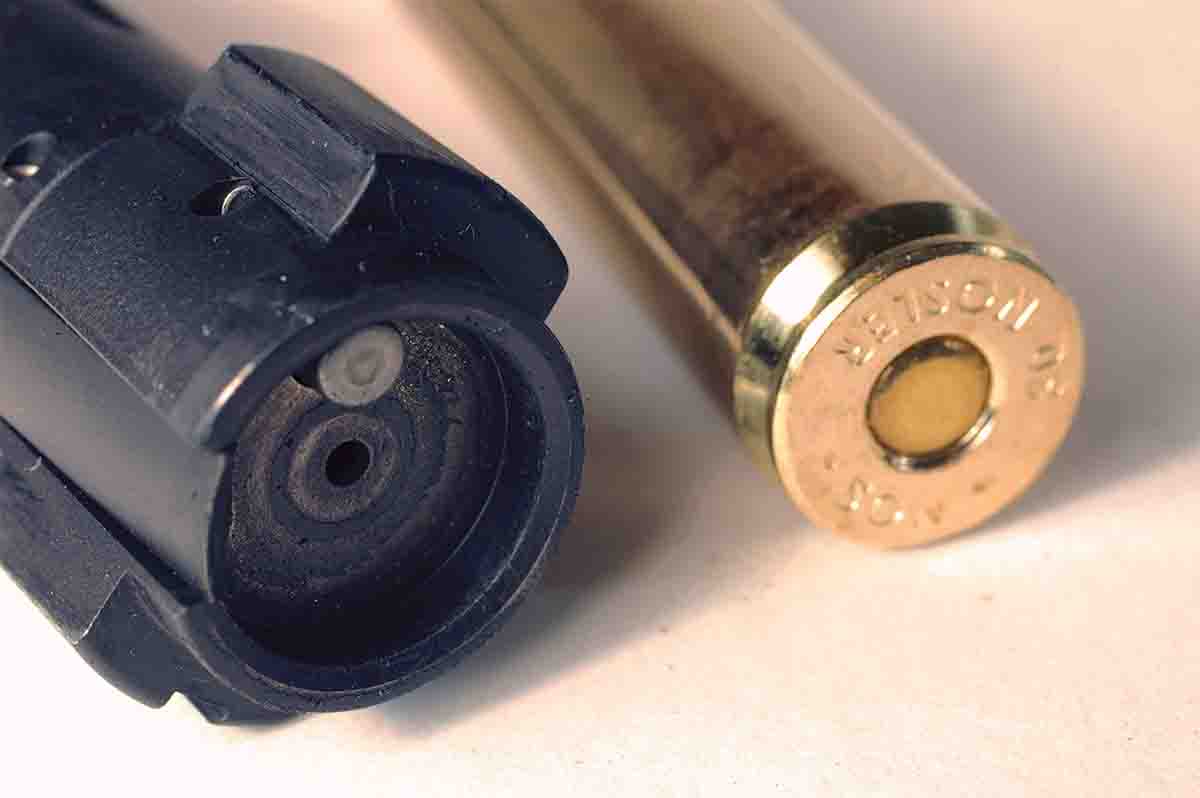
With handloads, extreme velocity spreads ranged from 37 fps to 22 fps when chronographing five shots using Nosler 190-grain Custom Competition bullets. Velocity spreads varied from 47 fps to 11 fps with 190-grain AccuBond Long Range bullets. As far as velocity, Nosler 190-grain AccuBond Long Range bullets are moving right along at 3,150 fps when loaded over 80.0 grains of IMR-7977.
The muzzle brake on the Long-Range significantly softened the kick from shooting heavy bullets and 80-some grains of powder. Though the continual rearward blast of powder gases from the brake soon made my head throb, even while wearing earplugs and big muffs. I finally placed a big shooting bag on the bench on the left side of the rifle rest, which seemed to deflect some of the blast. At least my head quit aching.
Removing the muzzle brake reduced the bark of the report. Recoil was tolerable for 10 shots or so off the bench, because the stock’s high comb kept my head erect and cheek tight on the comb so the recoiling rifle couldn’t get a running start at my face. Soon the scope’s crosshairs began to quiver as I anticipated the coming kick. Point of impact remained the same with the brake on and off.
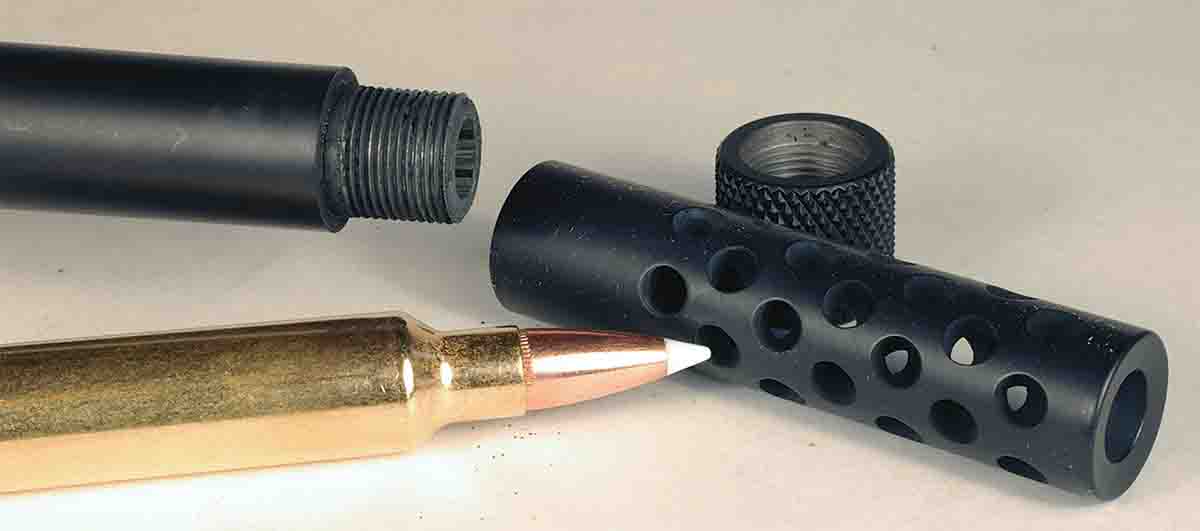
The first five-shot group recorded on a target was shot with Nosler Trophy Grade 180-grain AccuBond bullets. The group measured .99 inch, so that met Nosler’s guarantee of its rifle shooting MOA groups. I hated to waste such great hunting bullets on something as thin as paper targets, but subsequent groups hovered slightly over an inch.
Nosler Trophy Grade cartridges loaded with 210-grain AccuBond Long Range bullets failed to shoot quite as well, but at 300 yards five bullets grouped slightly inside 3 inches. The rifle seemed to start spreading bullets after 30 shots or so. Soaking and scrubbing the barrel with solvent and wiping out the gunk restored the accuracy.
To determine if that level of precision from the bench transferred to hunting positions, the rifle was shot from sitting and prone positions. Sitting with the rifle supported on a tripod, I twisted up the elevation dial on the Meopta scope to compensate for bullet drop while shooting at small rocks on a hillside at 350 yards. I cracked a lot of them. When I missed, it wasn’t by much, and I at least kicked dirt on them. From prone, I wished the rifle had a slightly longer length of pull to position my eye farther back from the scope. Setting the rifle a foot or more above the ground helped me get down behind the scope with my cheek tight on the comb. A three-shot group measured 2.87 inches at 300 yards with Nosler cartridges loaded with 210-grain AccuBond bullets. I was more than happy with that, and it showed the Long-Range rifle lived up to its accuracy guarantee.
The Long-Range rifle retails for $2,495. Contact Nosler at 800-285-3701 or online at www.nosler.com.


